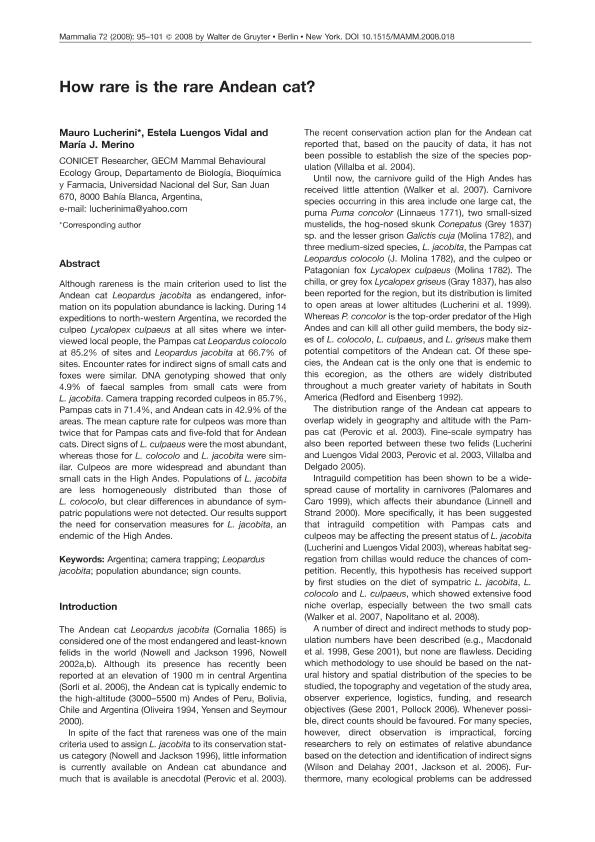Mostrar el registro sencillo del ítem
dc.contributor.author
Lucherini, Mauro

dc.contributor.author
Luengos Vidal, Estela Maris

dc.contributor.author
Merino, Maria Jose

dc.date.available
2019-04-26T19:18:06Z
dc.date.issued
2008-06
dc.identifier.citation
Lucherini, Mauro; Luengos Vidal, Estela Maris; Merino, Maria Jose; How rare is the rare Andean cat?; De Gruyter; Mammalia; 72; 2; 6-2008; 95-101
dc.identifier.issn
0025-1461
dc.identifier.uri
http://hdl.handle.net/11336/75145
dc.description.abstract
Although rareness is the main criterion used to list the Andean cat Leopardus jacobita as endangered, information on its population abundance is lacking. During 14 expeditions to north-western Argentina, we recorded the culpeo Lycalopex culpaeus at all sites where we interviewed local people, the Pampas cat Leopardus colocolo at 85.2% of sites and Leopardus jacobita at 66.7% of sites. Encounter rates for indirect signs of small cats and foxes were similar. DNA genotyping showed that only 4.9% of faecal samples from small cats were from L. jacobita. Camera trapping recorded culpeos in 85.7%, Pampas cats in 71.4%, and Andean cats in 42.9% of the areas. The mean capture rate for culpeos was more than twice that for Pampas cats and five-fold that for Andean cats. Direct signs of L. culpaeus were the most abundant, whereas those for L. colocolo and L. jacobita were similar. Culpeos are more widespread and abundant than small cats in the High Andes. Populations of L. jacobita are less homogeneously distributed than those of L. colocolo, but clear differences in abundance of sympatric populations were not detected. Our results support the need for conservation measures for L. jacobita, an endemic of the High Andes.
dc.format
application/pdf
dc.language.iso
eng
dc.publisher
De Gruyter

dc.rights
info:eu-repo/semantics/openAccess
dc.rights.uri
https://creativecommons.org/licenses/by-nc-sa/2.5/ar/
dc.subject
Argentina
dc.subject
Camera Trapping
dc.subject
Leopardus Jacobita
dc.subject
Population Abundance
dc.subject
Sign Counts
dc.subject.classification
Otras Ciencias Biológicas

dc.subject.classification
Ciencias Biológicas

dc.subject.classification
CIENCIAS NATURALES Y EXACTAS

dc.title
How rare is the rare Andean cat?
dc.type
info:eu-repo/semantics/article
dc.type
info:ar-repo/semantics/artículo
dc.type
info:eu-repo/semantics/publishedVersion
dc.date.updated
2019-03-27T13:30:09Z
dc.journal.volume
72
dc.journal.number
2
dc.journal.pagination
95-101
dc.journal.pais
Alemania

dc.description.fil
Fil: Lucherini, Mauro. Universidad Nacional de San Luis. Facultad de Química, Bioquímica y Farmacia; Argentina. Consejo Nacional de Investigaciones Científicas y Técnicas; Argentina
dc.description.fil
Fil: Luengos Vidal, Estela Maris. Universidad Nacional de San Luis. Facultad de Química, Bioquímica y Farmacia; Argentina. Consejo Nacional de Investigaciones Científicas y Técnicas; Argentina
dc.description.fil
Fil: Merino, Maria Jose. Universidad Nacional de San Luis. Facultad de Química, Bioquímica y Farmacia; Argentina
dc.journal.title
Mammalia

dc.relation.alternativeid
info:eu-repo/semantics/altIdentifier/doi/http://dx.doi.org/10.1515/MAMM.2008.018
dc.relation.alternativeid
info:eu-repo/semantics/altIdentifier/url/https://www.degruyter.com/view/j/mamm.2008.72.issue-2/mamm.2008.018/mamm.2008.018.xml
Archivos asociados
